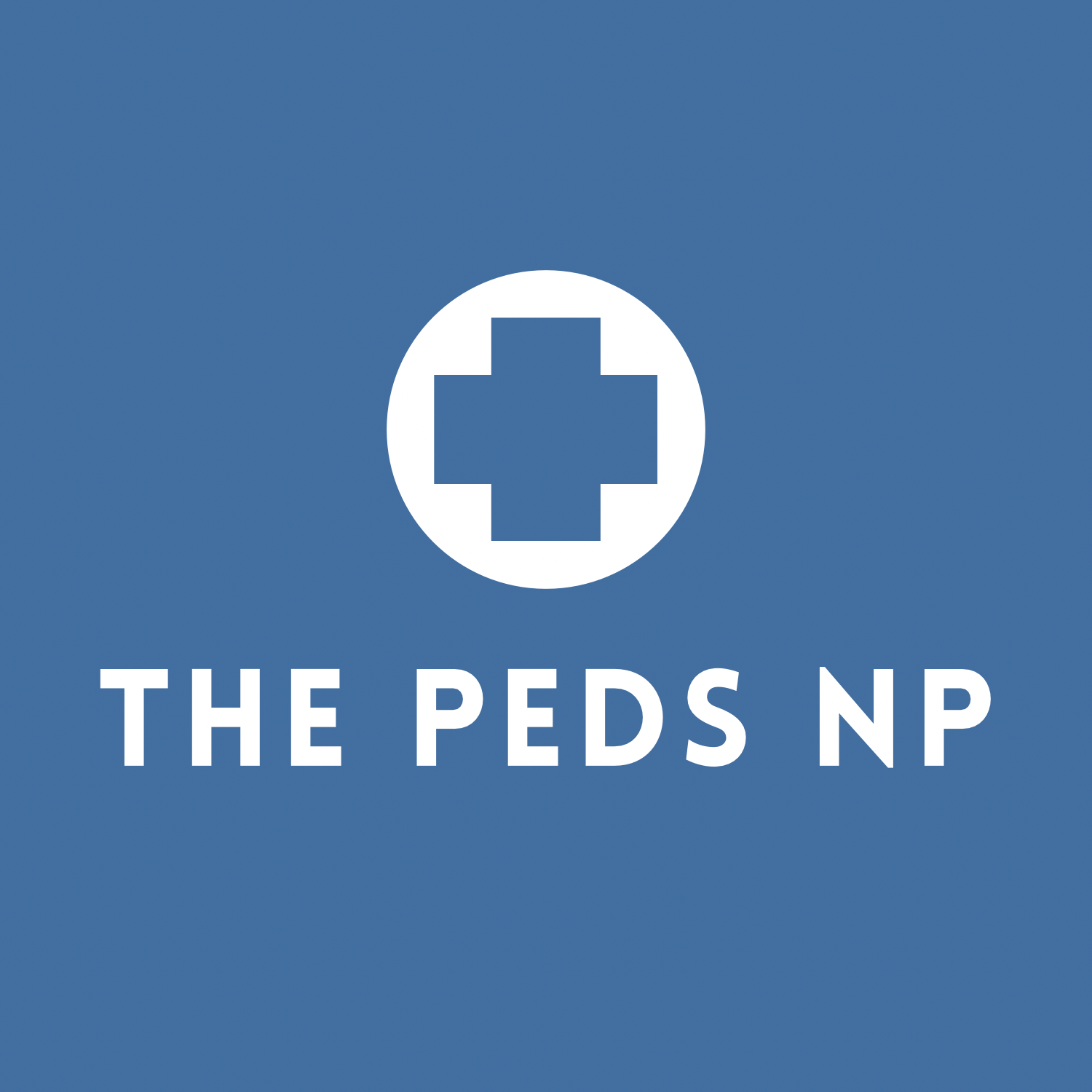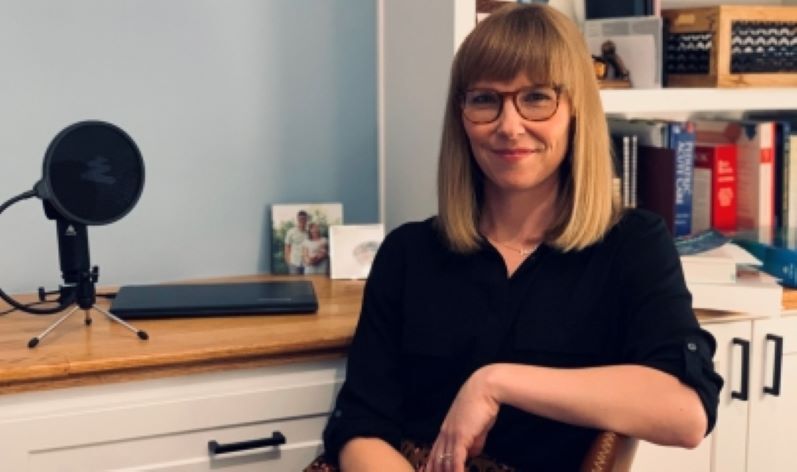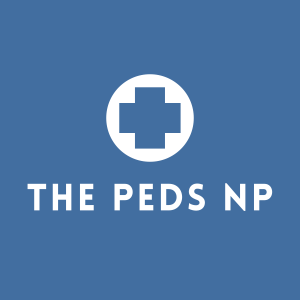

69.6K
Downloads
78
Episodes
The Peds NP provides a practical approach to the application of evidence-based practice in pediatrics using a conversational commentary to help you apply the most current literature to your practice with children. The host is Becky Carson, DNP, APRN, CPNP-PC/AC. She is a dual-certified pediatric nurse practitioner in acute and primary care and faculty member at the Duke University School of Nursing in Durham, North Carolina. Through an approachable review of the literature, you can easily apply knowledge to clinical practice to improve outcomes in pediatric care. Disclaimers & Show Notes: www.thepedsnp.com

Becky Carson, DNP, APRN, CPNP-PC/AC
Welcome to The Peds NP! I created this podcast as an asynchronous way to help my nurse practitioner students apply the concepts of our evidence-based courses to the patients that they care for at the bedside each and every day. The views are my own. Disclaimer and more at thepedsnp.com
Episodes

Thursday Jul 15, 2021
Amoxicillin Allergy (S3 Ep. 28)
Thursday Jul 15, 2021
Thursday Jul 15, 2021
Ten percent of Americans report an allergy to amoxicillin, yet most of these don't represent a true allergy. Today we discuss the types of drug allergies, how to determine if the allergy can be removed, and second line drugs for true PCN allergy with the goal of being outstanding stewards of antimicrobial stewardship.
References
American Academy of Pediatrics. (2013). The diagnosis and management of acute otitis media. Pediatrics, 131(3), p. e964-e999. doi:10.1542/peds.2012-3488
Chaudry, S.B., Veve, M.P., & Wagner, J.L. (2019). Cephalosporins: A focus on side chains and beta-lactam cross reactivity. Pharmacy, 7(3), p. 103. doi: 10.3390/pharmacy7030103
Mill, C., Primeau, M.N., Medoff, E., Lejtenyi, C., O’Keffe, A., Netchiporouk, E., … & Ben-Shoshan, M. (2016). Assessing the diagnostic properties of a graded oral provocation challenge for the diagnosis of immediate and nonimmediate reactions to amoxicillin in children. JAMA Pediatrics, 170(6), e160033. doi:10.1001/jamapediatrics.2016.0033
Shenoy, E.S., Macy, E., Rowe, T., & Blumenthal, K.G. (2019). Evaluation and management of penicillin allergy: A review. JAMA, 321(2), p. 188-199. doi:10.1001/jama.2018.19283
Shulman, S.T., Bisno, A.L., Clegg, H.W., Gerber, M.A., Kaplan, E.L., Lee, G., … & Van Beneden, C. (2012) Clinical practice guideline for the diagnosis and management of Group A Streptococcal pharyngitis: 2012 Update by the Infectious Diseases Society of America. Clinical Infectious Diseases, 55(10), p. e86-102. DOI: 10.1093/cid/cis629
Vyles, D., Chiu, A., Routes, J., Castells, M., Phillips, E.J., Kibicho, J., & Brousseau, D.C. (2018). Antibiotic use after removal of penicillin allergy label. Pediatrics, 141(5), e20173466. doi: 10.1542/peds.2017-3466.

Wednesday Jul 07, 2021
How to ace the test and eat a burrito (S3 Ep. 27)
Wednesday Jul 07, 2021
Wednesday Jul 07, 2021
I've got incredible burrito-eating skills like you've never seen. These epic Tex-Mex talents translate to test-taking strategies that are a sure-fire way to effectively implement critical thinking.
References:
Fernandez-Plaza, A., Saiz-Mendiguren, R., Garcia-Lallana, A., Viteri-Ramirez, G., Etxano, J., & Bondia Garcia, J.M. (2012). Ileo-ileal intussusceptions in a child complainting of abdomnial pain. Eurorad, Case 10092. doi: 10.1594/EURORAD/CASE.10092
Maaks, D.L.G., Starr, N.B., Brady, M.A., Gaylord, N.M., Driessnack, M., & Duderstadt, K.G. (2019). Pediatric Primary Care (7th ed). St Louis: Saunders Elsevier.
PNCB. (2019). PNCB announces unprecedented action for CPNP-AC exam integrity. Retrieved online from https://www.pncb.org/sites/default/files/resources/CPNP-AC_Exam_Press_Release_FINAL_3-4-2019.pdf
Wiersma, F., Allema, J.H., & Holscher, H.C. (2006). Ileoileal intussusception in children: ultrasonographic differentiation from ileocolic intussusception. Paediatric Radiology, 36(11), 1177-1181. doi: 10.1007/s00247-006-0311-2

Wednesday Jun 23, 2021
Kids say the darndest things! (S3 Ep. 26)
Wednesday Jun 23, 2021
Wednesday Jun 23, 2021
When patients (or parents!) use unique phrasing of a phenomenon, we must interpret their description of the experience in laymen's terms using clarifying questions while being attentive to inaccurate use of medical terms. Let a kid tell you their story and you'll learn everything you need to know. Hear what I mean with a couple of real GI examples from my week.
References
Tate, J.E., & Bresee, J.S. (2012). Principles and Practice of Pediatric Infectious Diseases (Fourth ed.). Elsevier: China.

Thursday Jun 17, 2021
What are you wearing?: Navigating guidelines in bronchiolitis (S3 Ep. 25)
Thursday Jun 17, 2021
Thursday Jun 17, 2021
Having a sense of fashion and listening to what the style gurus tell us "what not to wear" is similar to provider practice and the clinical practice guidelines published by our national authorities. Yet, somehow jorts came back into fashion and albuterol trials remain common practice for bronchiolitis. What will you wear and do?
References
Condella, A., Mansbach, J.M., Hasegawa, K., Dayan, P.S., Sullivan, A.F., Espinola, J.A., & Camargo, C.A. (2018). Multicenter study of albuterol use among infants hospitalized with bronchiolitis. Western Journal of Emergency Medicine, 19(3), 475-483. doi: 10.5811/westjem.2018.3.35837
Ralston, S.L., Lieberthal, A.S., Meissner, H.C., Alverson, B.K., Baley, J.E., Gadomski, A.M… & Hernandez-Cancio, S. (2014). Clinical practice guideline: The diagnosis, management, and prevention of bronchiolitis. Pediatrics, 134(5), e1474-e1502. doi: 10.1542/peds.2014-2742

Wednesday Jun 02, 2021
Heat and Sun Issues in Summer (S3 Ep. 24)
Wednesday Jun 02, 2021
Wednesday Jun 02, 2021
As the hottest part of summer approaches and kids spend more time playing outside, pediatric providers need to be ready to recognize heat-related illness and offer savvy perspectives on how to protect kids from the sun's harmful rays.
References:
American Academy of Pediatrics. (2011). Ultraviolet radiation: A hazard to children and adolescents. Pediatrics, 127(3), 588-597. doi:10.1542/peds.2010-3501
Center for Biological Diversity. (2021, March 9). Hawai’I senate bill bans harmful sunscreen chemicals. https://biologicaldiversity.org/w/news/press-releases/hawaii-senate-bill-bans-harmful-sunscreen-chemicals-2021-03-09/
Mangus, C.W., & Canares, T.L. (2019). Heat-related illness in children in an era of extreme temperatures. Pediatrics in Review, 40(3), 97-107. doi: 10.1542/pir.2017-0322
U.S. Food & Drug Administration. (2017). Sun protective factor (SPF). Retrieved online from https://www.fda.gov/about-fda/center-drug-evaluation-and-research-cder/sun-protection-factor-spf

Tuesday May 18, 2021
Trouble in clinical paradise (S3 Ep. 23)
Tuesday May 18, 2021
Tuesday May 18, 2021
Thank you preceptors for your tireless support of students who cannot learn the art of pediatric healthcare without your bedside teaching. This relationship born out of duty, generosity, and mutual respect can create lifelong collegial friendships. But what should students do if they notice problems in clinical? Today we explore how you should think, do, and say when evidence-based practice gets put in a corner.
References:
American Academy of Pediatrics. (2020). Tips for successful clerkships. Retrieved online from https://services.aap.org/en/career-resources/medical-students/tips-for-successful-clerkships/
Grenny, J., Patterson, K., Switzler, A., & McMillan, R. (2011). Crucial Conversations: Tools for talking when stakes are high (2nd ed.). McGraw Hill Professional.
Maaks, D., Starr, N.B., Brady, M.A., Gaylord, N.M., Driessnack, M., & Duderstadt, K.G. (2020). Burn’s Pediatric Primary Care (7th ed.). Elsevier.
ThriveAP. (2018). How do you deal with a bad clinical placement. Retrieved from https://thriveap.com/blog/how-do-you-deal-bad-clinical-placement.

Wednesday May 12, 2021
The Peds NP’s Baby Registry (S3 Ep. 22)
Wednesday May 12, 2021
Wednesday May 12, 2021
On this Mother's Day edition of The Peds NP podcast, we consider the perfect baby shower gift for an expecting mother. By using your knowledge of pediatric physiology, growth, and development, you can turn that baby registry into an educational opportunity to promote health and wellness for a new family.

Tuesday May 04, 2021
Now what? Post-graduation tips for the new PNP (S2 Ep. 21)
Tuesday May 04, 2021
Tuesday May 04, 2021
Once the exams are all taken, the papers submitted, and the grades are in... you've still got work to do. Healthcare professions require career-long learning, so join me as I discuss some options for staying current and engaged in pediatric learning after you walk off the stage and into clinical practice.

Wednesday Apr 21, 2021
Making febrile seizures simple (S2 Ep. 20)
Wednesday Apr 21, 2021
Wednesday Apr 21, 2021
Whatever your social life looks like when you go home, I want you to know how important your work in pediatrics is to so many children! Fever is common, the presentation is simple, and this episode reinforces the management of simple febrile seizures according to the 2011 AAP guidelines.
References:
(AAP), Subcommittee on Febrile Seizures, American Academy of Pediatrics. (2011). Neurodiagnostic evaluation of the child with a simple febrile seizure. Pediatrics, 127(2), 389-394.
Abolfazl, N.-Z., Francois, D., Valerie, H., Pruvost, I., Bennour, A., & Martinot, A. (2013). Risk of bacterial meningitis in young children with a first seizure in the context of fever: a systematic review and meta-analysis. PloS one, 8(1), 55270. doi:10.1371/journal.pone.0055270
Natsume, J., Hamano, S.-I., Iyoda, K., Kanemura, H., Kubota, M., Mimaki, M., . . . Sugie, H. (2017). New guidelines for management of febrile seizures in Japan. Brain & development, 39(1), 2-9. doi:https://dx.doi.org/10.1016/j.braindev.2016.06.003
Seattle Children’s Hospital. (2019). Febrile seizure: Acute presentation v2.0. Retrieved online from https://www.seattlechildrens.org/pdf/febrile-seizures-pathway.pdf.

Tuesday Apr 13, 2021
How to write a summary statement (S2 Ep. 19)
Tuesday Apr 13, 2021
Tuesday Apr 13, 2021
A novel is to the clinical note what a summary statement is to Cliff's Notes. A summary statement is a concise phrase of synthesized patient information that transforms your assessment, and formulating one is a critical skill for any provider to learn. Understand the essential components of a summary statement and hear a few good and bad examples on this episode.
References:
Siegel, M. (2017). Concise summaries only, please. Yale School of Medicine News. Retrieved online at https://medicine.yale.edu/news-article/15646/
University of Florida Department of Medicine. (2021). Instructions for write-ups. Retrieved online at https://clerkship.medicine.ufl.edu/clerkship-requirements/write-ups/instructions-for-write-ups/